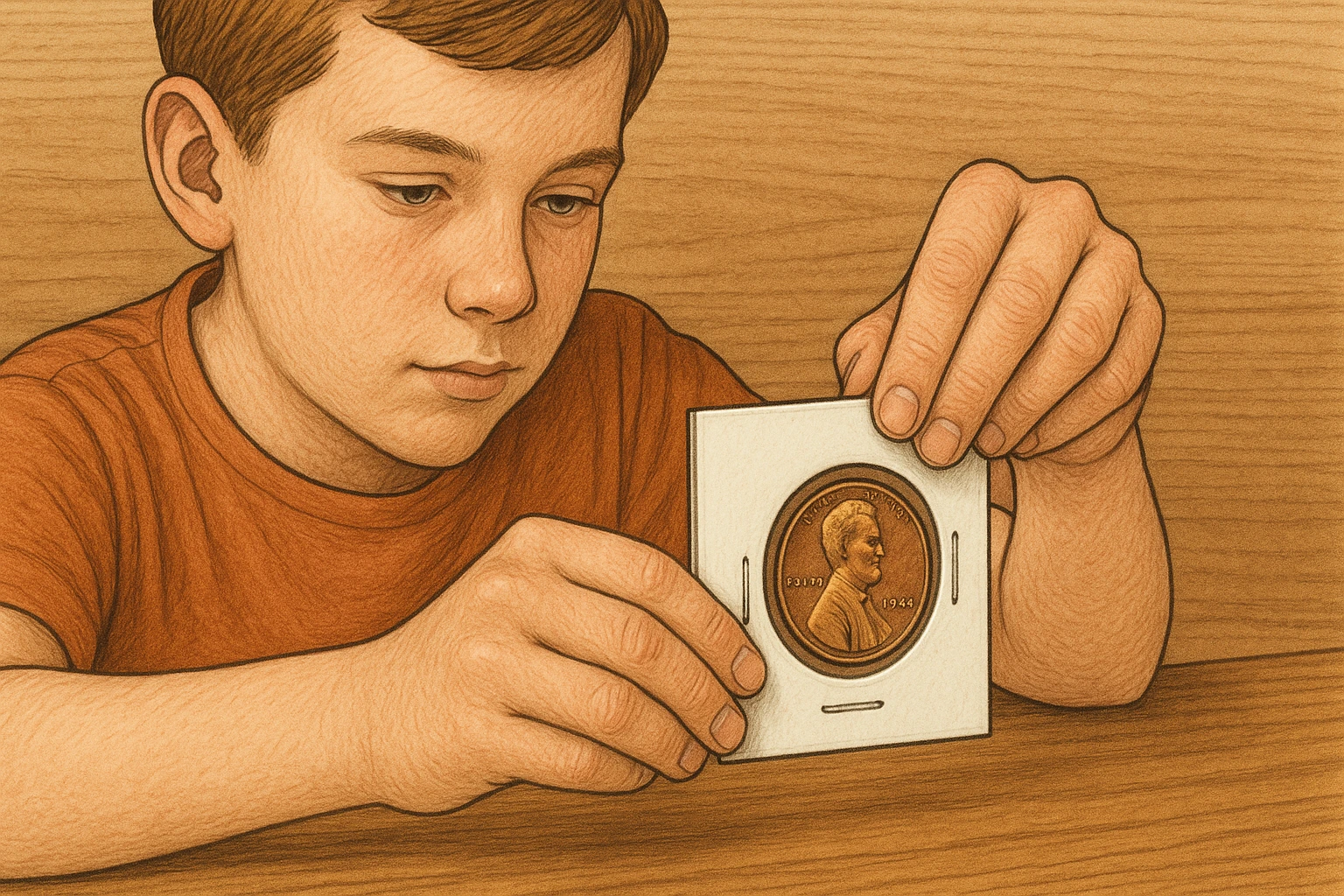Wheat Pennies from the 1940: How Do You Know That You’re Holding a Treasure?
If you’ve ever stumbled across a wheat penny from the 1940s—tucked in a dusty drawer, clinking in your grandparent’s old piggy bank, or found during a casual coin roll hunt—you might be holding more than just spare change. You could be holding a tangible slice of American history… or a collector’s jackpot in disguise.
But how do you know whether that copper-toned coin is a common artifact or a numismatic treasure holding 5-6-figures’ 1940 wheat penny value? The answer lies in a closer look at the history, appeal, and subtle markers that distinguish ordinary wheat cents from truly valuable ones.

Why Are Wheat Pennies Special?
Wheat pennies, officially called Lincoln Wheat Cents, were minted from 1909 to 1958, becoming a staple in American pockets for nearly five decades. Their significance goes far beyond simple currency—these coins were part of a cultural and historical shift in American coinage.
Let’s break down what makes them stand out:
| Feature | Why It Matters |
| First U.S. Coin to Feature a Real Person | Prior to 1909, U.S. coins mostly featured abstract representations of Liberty. With Abraham Lincoln’s face on the obverse, the Wheat Penny marked a bold move to honor real individuals. |
| Iconic Reverse Design | The back features two elegant stalks of wheat flanking the words “ONE CENT.” It’s this reverse design that gives the coin its nickname. |
| Historical Resonance | The 1940s Wheat Pennies carry the weight of a world at war—struck during a time when materials, priorities, and American life were all in flux. |
| Enduring Collector Demand | Thanks to their age, affordability, and historic design, these coins are a popular gateway into coin collecting. Rarer variants from the 1940s remain in high demand. |
For collectors, especially those focused on wartime America, a 1940s Wheat Penny isn’t just pocket change—it’s an emblem of resilience and nostalgia.
The 1940s: A Decade of Transition
The 1940s were anything but ordinary for the U.S. Mint. World War II meant shifts in metal use, massive coin circulation, and fluctuating mint outputs. As a result, Wheat Pennies from this decade are packed with variation, and some are surprisingly rare.
Some key facts about 1940s wheat pennies:
- Material Composition: Most 1940s Wheat Pennies are made of 95% copper and 5% tin and zinc. However, 1943 brought a surprise: due to copper shortages, the U.S. Mint produced pennies made from zinc-coated steel—these “steelies” are iconic in their own right.
- Minting Locations: Pennies were struck in Philadelphia (no mint mark), Denver (“D”), and San Francisco (“S”). Mint marks play a crucial role in determining rarity and value.
- Survival Rate: While millions were minted, only a small fraction have survived in high grades. Many coins were lost, worn down, or used in wartime donation drives.
What Collectors Love About the 1940s Pennies
Wheat pennies from the 1940s are accessible yet full of potential surprises. Whether you’re a seasoned numismatist or just dipping your toes in the hobby, these coins are an ideal mix of history, affordability, and mystery.
Here’s why collectors love them:
- They Tell Stories: Each coin circulated during a critical decade—wartime economy, post-war recovery, and changing minting practices.
- They’re Still Findable: Unlike ultra-rare gold coins or early cents, wheat pennies still show up in old jars, inherited boxes, and pocket change.
- They’re Often Misunderstood: Many people discard them without realizing their potential value, especially if they overlook mint marks or minor design variations.
Spotting the True Gems—Date, Mint Mark & Condition
Knowing that 1940-era wheat pennies can hide in plain sight is exciting; learning to separate the everyday pieces from the jackpot takes a sharper eye. Below are the three checks seasoned collectors swear by, plus a rapid tech shortcut that can save you hours of squinting.
1 Check the Date & Mint Mark
A small letter beneath “1940” can swing a penny’s value from pocket change to prized collectible. Focus on D (Denver) and S (San Francisco) marks—and remember that some years hide famous metal or strike anomalies.
| Year / Variety | Key Mint Mark(s) | Composition | Typical MS-65 Range* | Auction Records & Rarities |
| 1940-P | — | 95 % copper | $8–15 | — |
| 1940-D | D | 95 % copper | $12–25 | — |
| 1940-S | S | 95 % copper | $18–30 | PCGS MS-65 RD sold for $30 in 2014 |
| 1943 Steel | P / D / S | zinc-coated steel | $20–40 | Common but iconic |
| 1943 Copper | P / D / S | error 95 % copper | — | One 1943-D copper cent fetched $840,000 in 2021 |
| 1944 Steel | P / D / S | error zinc-coated steel | — | 1944-S MS-66 sold for $408,000 |
*Typical retail prices as of mid-2025 for problem-free coins.
2 Examine the Condition
Grades may look like algebra at first glance, but they translate directly into cash:
- XF 40–AU 58 (light wear) – retains detail but shows high-point rub; most 1940-dated pieces sit here and trade for $1–5.
- MS 60–MS 64 (uncirculated) – full mint luster with minor marks; $8–30 for common dates.
- MS 65 + (gem) – nearly flawless surfaces and blazing color; premiums climb fast, especially for “RD” (full red) copper.
Because the market rewards eye appeal, avoid cleaning—a single scratch can erase decades of value. Even modest nicks knock a gem back several grade brackets.
3 Hunt for Errors & Variety Gold
A microscope (or a sharp phone camera) reveals clues that launch values into five or six figures:
- Doubled Dies – look for ghost-like doubling on LIBERTY or the date; dramatic 1944-D examples bring strong premiums.
- Off-Center Strikes – the further the design slides toward the rim, the scarcer (and pricier) the coin.
- Wrong-Planchet Strikes – copper in 1943 or steel in 1944 flips wartime metal rules; genuine pieces can fund a college education.

The 30-Second Shortcut: Coin ID Scanner
Instead of memorizing mintages, open Coin ID Scanner, snap a photo, and receive:
- Instant ID – year, mint, metal, plus high-res magnification of critical details.
No more guesswork—just a quick confirmation before you celebrate (or keep hunting).
Where Can You Still Find Hidden Wheat Penny Treasures?
While it’s true that millions of 1940s wheat pennies were made, few have survived in collectible condition. Still, they surface regularly in the following places:
| Location | Why It Works |
| Family Coin Jars & Inherited Collections | Many older generations stashed coins in coffee tins, drawers, and boxes without ever checking value. |
| Estate Sales & Flea Markets | Sellers often bundle pennies in bags or jars—sometimes pricing them by weight. |
| Coin Roll Hunting at Banks | Request rolls of cents and sort through them; some collectors report finding 1940s coins in circulated rolls. |
| Online Marketplaces (eBay, local auctions) | With a sharp eye, you can spot undervalued lots with hidden gems—especially unsearched wheat penny lots. |
| Garage Sales & Antique Fairs | Vintage collections are often sold off without proper evaluation, especially by non-collectors. |
Pro tip: Keep a small magnifying glass and your phone handy when attending flea markets or yard sales—you never know what’s lying in a dusty coin box.
What to Do If You Think You’ve Found a Valuable Penny
You’ve found a promising wheat penny—now what? The next steps determine how much your coin is ultimately worth and how well it’ll hold its value over time.
Step 1: Do Not Clean the Coin
It may be tempting to scrub off grime, but never clean coins—even gently. Cleaning removes the natural patina and can reduce a coin’s value by 50% or more.
Step 2: Protect It Properly
Store it in:
- A 2×2 cardboard coin flip
- A PVC-free plastic sleeve or airtight capsule
- Or even a coin album with protective pages
Humidity and handling are enemies of copper. Use gloves when handling especially bright or lustrous coins.
Step 3: Consider Getting It Graded
If your penny looks flawless or has a known error (like a double die or wrong planchet), submit it to a grading servicelike:
- PCGS (Professional Coin Grading Service)
- NGC (Numismatic Guaranty Company)
These organizations certify your coin’s authenticity and condition, which:
- Adds credibility for resale
- Boosts potential auction value
- Helps preserve your coin for future generations
The Coin ID Scanner: Your Smartest Tool
Instead of mailing your coin or relying solely on your eye, you can use the Coin ID Scanner app to:
- Instantly identify mint mark, date, and metal composition
- Spot errors that you might miss (like micro-doubling or die cracks)
- Get real-time market value estimates
- Organize your finds into a digital portfolio
- Stay updated with numismatic tips and news from around the world
Whether you’re traveling, shopping, or simply browsing a box of old change, the app can turn your phone into a portable coin lab.
A 1940s wheat penny isn’t just a coin—it’s a living link to wartime America, a relic that passed through thousands of hands, and potentially, a hidden gem waiting to be recognized. With a careful eye and the right tools, you can be the one to uncover a penny worth hundreds—or even thousands—of dollars.
So next time you hear that familiar jingle in your change, remember: that one-cent piece might just be a ticket into the fascinating world of rare coin collecting.
And thanks to modern tools like Coin ID Scanner, it’s never been easier to tell history from treasure.


